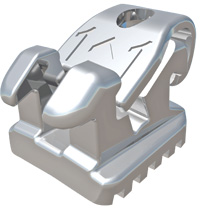Time3 Self-Ligating Bracket

Bonding
T3 brackets should be bonded with the spring clip in the open position. This minimizes any chance of adhesive interfering with the operation of the clip. Clips should be closed when indirect bonding.
Use traditional direct bond adhesive when bonding T3 brackets. The T3 one piece design with microetched Quadra Grip™ base has proven to provide excellent bond strength.
T3 brackets provide visual cues to aid in alignment during bonding. The slot, occlusal edge of pad, and gingival edge of clip should be aligned to be parallel with the desired occlusal plane. Mesial and distal bonding pad edges of upper centrals and laterals and all cuspids should be bonded parallel to the tooth’s long axis.
After the adhesive has cured, install arch wires and close the spring clip. The clip should only be opened and closed using the specially designed T3 bracket instrument.
To open the clip, insert the instrument in the labial opening and gently rotate the instrument between the thumb and forefinger toward the gingival. When the clip is open, there is a resistance to further opening. Do not attempt to over-rotate the clip.

 Come See Us
Come See Us

